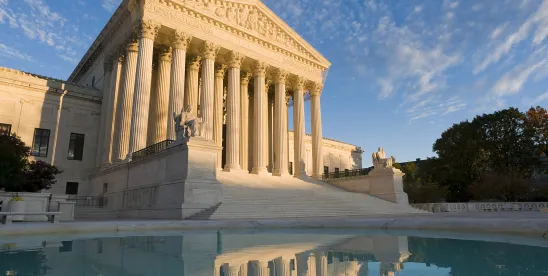To anyone who has followed the case of United States v. Skrmetti, especially those who attended or listened to the oral argument, the U.S. Supreme Court’s 6–3 holding that a Tennessee law prohibiting certain medical procedures for transgender minors was not subject to heightened or strict scrutiny under the Equal Protection Clause of the Fourteenth Amendment should have come as no surprise.
Although there was an array of concurring and dissenting opinions, the majority opinion, written by the Chief Justice, was joined by the Court’s other five jurisprudentially conservative Justices, while the three “liberals,” Justices Sotomayor, Kagan, and Jackson, dissented.
Joining more than 20 states that have restricted sex transition treatments for minors, Tennessee enacted a statute entitled “Prohibition on Medical Procedures Performed on Minors Related to Sexual Identity” (SB1) that:
[P]rohibits healthcare providers from prescribing, administering, or dispensing puberty blockers or hormones to any minor for the purpose of (1) enabling the minor to identify with, or live as, a purported identity inconsistent with the minor’s biological sex, or (2) treating purported discomfort or distress from a discordance between the minor’s biological sex and asserted identity. At the same time, SB1 permits a healthcare provider to administer puberty blockers or hormones to treat a minor’s congenital defect, precocious puberty, disease, or physical injury.
Three transgender minors, their parents, and a physician challenged SB1 as violative of the Equal Protection Clause of the Fourteenth Amendment. Reversing a holding by the U.S. District Court for the Middle District of Tennessee, the U.S. Court of Appeals for the Sixth Circuit held that the law did not necessitate heightened scrutiny and otherwise satisfied rational basis analysis, and the Supreme Court affirmed.
The Supreme Court held that SB1 is not subject to heightened scrutiny under the Equal Protection Clause because its classifications are not sex-based. The two classifications that it does make are based upon age (restricting minors’ access to treatments available to persons over age 18) and upon medical use (permitting puberty blockers and hormones for minors for some conditions, but excluding gender dysphoria, gender identity disorder, or gender incongruence). Neither of these classifications turns on sex, and neither requires anything more than rational basis scrutiny.
The Court found no “invidious discriminatory purpose” or impermissible stereotypes that might trigger heightened scrutiny. In particular, SB1 doesn’t exclude anyone from medical treatments on the basis of transgender status. It simply removes one set of diagnoses—gender dysphoria, gender identity disorder, and gender incongruence—from the range of treatable conditions. “It distinguishes between minors who seek puberty blockers or hormones to treat the excluded treatments, and those minors who seek puberty blockers or hormones to treat other conditions. Although only transgender individuals seek treatment for gender dysphoria, gender identity disorder, and gender incongruence—just as only biological women can become pregnant—there is a ‘lack of identity’ between transgender status and the excluded diagnoses.”
The Supreme Court also rejected a comparison with Bostock v. Clayton County, 590 U. S. 644 (2020), where the Court had held that an employer who fires an employee for being gay or transgender violates the prohibition in Title VII of the Civil Rights Act of 1964 (“Title VII”) on discharging an individual “because of” their sex. Title VII’s “because of” test directs courts to “change one thing at a time and see if the outcome changes.” Applying that test, the Court held that the employer has penalized a member of one sex for a trait or action that it tolerates in members of the other. In the instant case, the Supreme Court declined to address whether Bostock’s reasoning reaches Title VII because the application of SB1 would be unaffected by a change in a minor’s sex or transgender status.
The Court went on to hold that SB1 satisfies the relaxed standard of rational basis review, under which the Court will uphold a statutory classification so long as there is “any reasonably conceivable state of facts that could provide a rational basis for the classification.” And here, there were many. While controversial, the state reasonably determined that administering puberty blockers or hormones to minors to treat gender dysphoria, gender identity disorder, or gender incongruence risks irreversible physical and mental consequences that minors lack the maturity to understand fully and often regret. In the end, the Court recognized that there is a cognizable debate about the science and policy concerning these medical treatments in an evolving field. Indeed, as the Chief Justice noted:
The voices in these debates raise sincere concerns; the implications for all are profound. The Equal Protection Clause does not resolve these disagreements. Nor does it afford us license to decide them as we see best. Our role is not “to judge the wisdom, fairness, or logic” of the law before us, . . . but only to ensure that it does not violate the equal protection guarantee of the Fourteenth Amendment. Having concluded it does not, we leave questions regarding its policy to the people, their elected representatives, and the democratic process.
A final note on the case: The Court’s decision in Skrmetti left open questions concerning the role of parents with respect to the treatment of their transgender children who are minors, and of the permissible range of physician conduct given law enforcement risks. My colleagues consider these and related questions here.
Continuing our reporting of the most recent action in the Supreme Court, we turn to Perttu v. Richards, another case in which the Chief Justice delivered the opinion of the Court. Here, the lineup was decidedly different from that in Skrmetti, with the Chief being joined by the three liberals plus Justice Gorsuch, while Justice Barrett was joined in dissent by the other three conservatives. The case concerned the requirement of the Prison Litigation Reform Act (PLRA) for prisoners with complaints about prison conditions to exhaust available grievance procedures before filing suit in federal court. Such exhaustion is not required, however, when a prison administrator threatens an inmate in order to prevent their use of these grievance mechanisms.
In this case, Kyle Richards alleged that Thomas Perttu, a prison employee, had sexually harassed him and others, and when Richards attempted to file grievance papers, Perttu destroyed them and threatened to kill Richards if he refiled. The issue in the case was whether prisoners are entitled to a jury trial on the issue of PLRA exhaustion of remedies when that question is intertwined with a merits issue subject to jury trial under the Seventh Amendment.
The Court’s opinion was lengthy, but, resolving a split in the circuit courts, the answer was brief. Going back to cases that were taught when I was in law school in the 1960s, the Court held that while a court may resolve factual disputes when determining whether it has subject-matter jurisdiction, the PLRA prevents a court from doing so when the factual disputes are intertwined with the merits.
In Nuclear Regulatory Commission v. Texas, the Court considered proceedings under the Atomic Energy Act of 1954, which generally prohibits the private possession of nuclear materials, including spent nuclear fuel, without a license that the Nuclear Regulatory Commission (the “Commission”) has the power to issue.
Here, a private company, Interim Storage Partners (ISP), applied for such a license to build a facility in West Texas to store such spent nuclear fuel. During the licensing proceedings, a Texas government agency submitted comments on a draft environmental impact statement prepared by the Commission. Fasken Land and Minerals, another private company, also submitted comments and sought to intervene. That petition was denied, and Fasken unsuccessfully challenged that ruling before the whole Commission and then before the D.C. Circuit. When the Commission issued a license to ISP, Texas and Fasken sought review in the Fifth Circuit, which vacated ISP’s license.
The Supreme Court reversed. Justice Kavanaugh wrote for the Court (with Justices Gorsuch, Thomas, and Alito dissenting) that, under the Hobbs Act, Congress specified that only a “party aggrieved” by a Commission licensing order may seek judicial review. And because both Texas and Fasken were not parties to the Commission’s licensing proceeding, they were not entitled to review of ISP’s award. Fasken, in particular, was barred because it had not sought en banc review in the Circuit Court or relief from the Supreme Court. With regard to both, the Court rejected the argument that they didn’t need to be parties to challenge ultra vires agency action under an exception that the Court held is to be applied narrowly. Because it held that neither Texas nor Fasken had the right of judicial review, the Court declined to decide whether the Commission had statutory authority to issue a license to ISP.
In Environmental Protection Agency v. Calumet Shreveport Refining, L.L.C., Justice Thomas delivered the opinion of the Court and was joined by both conservative and liberal colleagues, save for Justice Gorsuch, who, with the Chief Justice, dissented. Again, the decisions were lengthy, but the holding was simple. Under the Clean Air Act’s (CAA’s) venue provisions, challenges to “nationally applicable” Environmental Protection Agency (EPA) actions belong in the D.C. Circuit, while challenges to “locally or regionally applicable” EPA actions ordinarily belong in a regional circuit. However, the CAA makes an exception for local or regional actions that are “based on a determination of nationwide scope or effect” and accompanied by an EPA finding of this basis, which also must be challenged in the D.C. Circuit.
The Court applied this framework to the EPA’s 2022 denials of certain small refineries’ exemption petitions, holding that the refineries’ challenges belonged in the D.C. Circuit. While the EPA’s denials were only locally or regionally applicable, they fell within the “nationwide scope or effect” exception. In deciding whether an action is “nationally applicable” or only “locally or regionally applicable,” the Court acknowledged that the governing statute does not define the terms. So, the Court sensibly gave them their ordinary meaning, citing various dictionary definitions. The Gorsuch dissent conceded much in common with the majority but took issue with its multistep approach to determining whether the EPA’s actions were properly based on a determination of nationwide scope or effect.
I’ll confess limited interest in this EPA case itself, but I wonder whether the Court’s venue analysis will somehow predict the outcome of a future Court decision where a nationwide injunction is under challenge. That remains to be seen.
Finally, at least for this round, Justice Thomas and the EPA came back on stage with an opinion in another CAA case, Oklahoma v. Environmental Protection Agency. As noted previously, the CAA directs challenges to EPA actions to the D.C. Circuit if they are “nationally applicable” and to a regional circuit if they are only “locally or regionally applicable.” And again, the CAA has an exception for certain “locally or regionally applicable” actions “based on a determination of nationwide scope or effect,” which also must be brought in the D.C. Circuit.
In 2015, the EPA mandated more stringent national ambient air quality standards (NAAQS) for ozone. Each state submitted a state implementation plan (SIP) with regard to compliance with a “Good Neighbor” provision that requires SIPs to “contain adequate provisions” “prohibiting” in-state emissions activity that would interfere with other states’ NAAQS compliance. The EPA ultimately disapproved 21 states’ SIPs for failure to comply with the Good Neighbor provision. These states had asserted they did not need to propose new emissions-reduction measures, but the EPA disagreed based on independent consideration of each of the states’ submissions “on its own merits” and making individual determinations for each SIP.
Having stated in the Federal Register how it applied a “4-step framework” for evaluating SIP submissions, the “EPA asserted in the rule that its disapprovals would be reviewable only in the D.C. Circuit as either nationally applicable actions or, alternatively, as locally or regionally applicable actions falling within the ‘nationwide scope or effect’ exception based on EPA’s use of ‘the same, nationally consistent 4-step . . . framework’ and its evaluation for ‘national consistency.’”
States and industry petitioners challenged the EPA’s SIP disapprovals in regional circuits. Four of five circuits that ruled on the EPA’s motions to dismiss or transfer held that regional circuit review was proper. The Tenth Circuit, however, disagreed, granting the EPA’s motion to transfer suits by Oklahoma and Utah. The Tenth Circuit order was based upon the view that the EPA’s omnibus rule constituted a single, nationally applicable action, given its multistate application of “a uniform statutory interpretation and common analytical methods.”
Reversing the Tenth Circuit, the Supreme Court held that the EPA’s disapprovals of the Oklahoma and Utah SIPs are locally or regionally applicable actions reviewable in a regional circuit. In so holding, the Supreme Court applied the methodology discussed above in Calumet Shreveport Refining, L.L.C. Thus, a venue determination under the CAA “requires a two-step inquiry. First, courts identify the relevant EPA ‘action’ and ask whether it is ‘nationally applicable’ or only ‘locally or regionally applicable.’ If nationally applicable, challenges belong in the D.C. Circuit. If locally or regionally applicable, courts proceed to the second step to determine whether the ‘nationwide scope or effect’ exception applies to override the default rule of regional Circuit review.”
Here, the SIP disapprovals were based on state-specific plans, and the disapprovals were “undisputedly locally or regionally applicable actions.” Accordingly, the judgment of the Tenth Circuit was reversed and the case remanded. A sidenote: In this case, as in Calumet Shreveport Refining, Justice Thomas’s opinion was joined by all the other Justices except Justice Gorsuch, who, along with the Chief Justice, dissented, while Justice Alito recused himself.
Another interesting day, with the Court getting into the tough ones with pronounced divisions among the Justices. We’re in a race to the finish of the term, so stay tuned.




 />i
/>i
